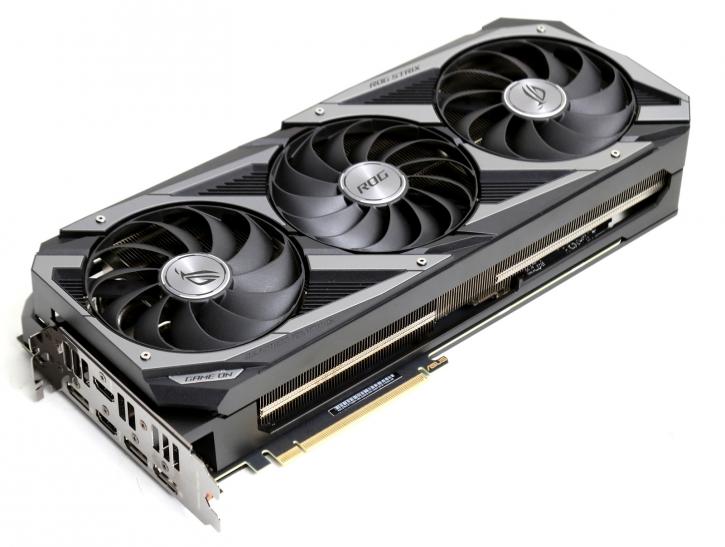Introduction
ASUS ROG STRIX GeForce RTX 3060 Gaming OC review
We move to ASUS, which released their ROG GeForce RTX 3060 STRIX Gaming OC, with 12GB, 3584 shading processors activated and a boost clock of 1882 MHz the card has been tweaked extensively straight out of the box for you. Much has been said, rumored, and spoken about this card. And weird it is that it's released after the Ti model made a fashionable introduction.
However, with that 3584 shading cores and Ampere architecture, this 3060 series is bound to impress in the 2560x1440 (WQHD) domain. If we look back at the previous generation, the product would sit at GeForce RTX 2070 (SUPER) performance levels and, in due time, will replace that series. If stock becomes available in plentiful volumes though. The GPU is again fabricated on an 8nm node derived from Samsung. This process further develops Samsung's 10nm process; no EUV is applied in production just yet. The first wave of announcements has seen the GeForce RTX 3080 and 3090 being released first, and, as a bit of a surprise, the GeForce RTX 3060 Ti and 3070. It's now late February 2021 and NVIDIA is set to release its more 'regular' 3060 prices 329 USD. As you will have noticed, the 3060 GPU cores count is about 26 percent lower than with the RTX 3060 Ti, which has a GA104 chip with 4864 shading cores (shader/stream/cuda cores = all the same thing with a different name). NVIDIA is launching the 3060 series with the 12GB model, which's remarkably enough is 2GB more than the GeForce RTX 3080 (!). Later on, they'll likely silently slip in a 6 GB version, though that has not been confirmed. NVIDIA advertises the series with 13 'shader teraflops' and 25 'RT-ops', the latter giving an indication of the ray-tracing performance. Notable is that a change is in effect, the memory runs ar 15 Gbps as opposed to the usual 14 Gbps, likely to compensate for the perf hit of going 256-bit towards 192-bit on the memory bus due to that memory configuration. It's the same for the shader core cluster, it's clocked higher in the boost frequency compared to the Ti model, also compensating a bit for the lower number of shader cores.
The Ampere lineup nearly doubles ray-tracing performance with Gen2 ray-tracing cores and 3rd iteration Tensor cores. These cards will all be PCIe 4.0 interface compatible and offer HDMI 2.1 and DisplayPort 1.4a, but most importantly is that exorbitant shader processor count (referred to as CUDA cores by NVIDIA). With just over a third of the shader processor count seen from the flagship product, we now meet the NVIDIA GA106 GPU. And despite being a lower segmented card, it still holds a sizable GPU die. In this round, NVIDIA is not seeding Founder edition cards, aka FE GeForce RTX 3060. But of course, they do present the reference specification; a boost clock of 1780 MHz and a base clock of 1320 MHz.
| Model | Base Clock (MHz) | Boost Clock (MHz) | VRAM Base Clock (MHz) | VRAM Effective Datarate (MHz) | Max Power % |
| GeForce RTX 3060 | 1320 | 1780 | 1875 | 15000 | - |
| ASUS RTX 3060 STRIX OC | 1320 | 1882 | 1875 | 15000 | 23 |
| PALIT RTX 3060 DUAL OC | 1320 | 1837 | 1875 | 15000 | 6 |
| MSI RTX 3060 Gaming X TRIO | 1320 | 1852 | 1875 | 15000 | 6 |
| EVGA RTX 3060 XC | 1320 |
1882 |
1875 | 15000 |
12 |
| ZOTAC RTX 3060 AMP Wh. | 1320 |
1867 |
1875 | 15000 | 10 |
ASUS ROG STRIX GeForce RTX 3060 Gaming OC
It has to be stated, ASUS really needs to do something about loin naming, holy moly. But yeah, meet the ASUS ROG STRIX GeForce RTX 3060 Gaming OC. The premium card comes with that NVIDIA GA106 GPU, this time the revision 300 GPU SKU; it a proper shader core count paired with 12GB GDDR6 graphics memory at 192-bit running at 15 Gbps. Muscled up with cooling, this card is equipped with a dual-bios design with performance and silent mode; the three fans start to spin and cool once the GPU warms up. The card has a single (6+2) pin power header. Armed with a BIOS that offers an 1882 MHz Turbo (1780 MHz = reference) in the performance BIOS setting and a cooler that you'll bow to. This card manages to produce 32 Dba noise levels at temperatures under 60 Degrees C in a Silent BIOS mode. These are incredibly silent acoustics when under load. The card is rated by us at 167 Watt power as a typical draw. Despite that we test the factory twaekd model, it still overclocks quite well bringing, and accumulated it makes this product a notch faster than founder edition specifications for the base model.


